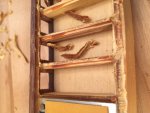Granitz
Member
- Joined
- Aug 21, 2017
- Messages
- 31
- Reaction score
- 1
Greetings folks!
This is my first post on the forum, but have been following it for a while and have been amazed at the wealth of knowledge here. Many thanks to all!
I'm currently cleaning, revalving, rewaxing, and retuning my Panjet 45 LMMM(a Goodwill special )and have noticed that several of the reed plates are resting on the hidden reed's base near the rivet. This has left a gap between the plate and the block, which has been filled in by the wax.
)and have noticed that several of the reed plates are resting on the hidden reed's base near the rivet. This has left a gap between the plate and the block, which has been filled in by the wax.
My question is: How much power and tone is lost, if any, and will notching out the block so the plate sits flush on the block make noticeable improvements? The accordion has been untouched since it left the factory.
Many thanks, folks!
This is my first post on the forum, but have been following it for a while and have been amazed at the wealth of knowledge here. Many thanks to all!
I'm currently cleaning, revalving, rewaxing, and retuning my Panjet 45 LMMM(a Goodwill special
My question is: How much power and tone is lost, if any, and will notching out the block so the plate sits flush on the block make noticeable improvements? The accordion has been untouched since it left the factory.
Many thanks, folks!

